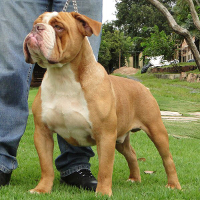 |
Buldogue Campeiro |
|
He is not recognized by the F.C.I. |
Origin |
Brazil | |
Translation |
Francis Vandersteen |
Brief historical summary |
| The Bulldog Campeiro has its origins in the Bulldogs that came to Brazil with European immigrants in the 17th century. They were used to capture wild cattle in hostile environments. |
General appearance |
| Bulldogs have a powerful, broad constitution, demonstrating strength and agility. The Bulldog Campeiro is an extremely hardy dog, with no health problems in common with the English Bulldog. The English Bulldog and the Bulldog Campeiro are two breeds with distinct functions. The English has a wonderful appearance and is a social dog. The Campeiro is a guard and working dog. |
Behaviour / temperament |
| The Campeiro is an extremely versatile dog, with excellent guarding and fighting qualities. It is extremely loyal to its owner and follows him like a shadow, appreciating the people who are part of its daily life and being very courageous. He's easy to adapt to, barks little, is calm, wary and jealous. He's very friendly with children (we've never seen a Bulldog Campeiro bite a child). |
Head |
||
Cranial region |
||
Head |
Broad, with strong jaws. | |
Skull |
Sufficiently broad. | |
Facial region |
||
Muzzle |
Short and broad, approximately 1/3 the length of the skull. Not as short as the current English Bulldog, nor as long as the Bullmastif. | |
Lips |
Slightly pendulous, with rounded cheeks. | |
Jaws and teeth |
Strong teeth with accentuated prognathism. | |
Eyes |
Oval, as dark as possible. | |
Ears |
Small, hanging or carried back, set high. | |
Neck |
| Moderate length, very strong. |
Body |
||
Back |
Moderately short, with an ascending line to the croup. | |
Chest |
Ample, of notable thickness. Well sprung ribs. | |
Tail |
| Normally, the Bulldog Campeiro is born without a tail or with a short one. Occasionally, some puppies are born with a long tail that exceeds the height of the hock, in which case it must be amputated. |
Limbs |
Forequarters |
||
Generality |
Vigorous. | |
Shoulders |
Broad, muscular and oblique. | |
Upper arm |
Slightly turned outwards. | |
Forearm |
Well developed, slightly sloping, with strong, straight bones. | |
Hindquarters |
||
Generality |
Muscular. | |
Upper thigh |
Well developed, indicating vigor and strength. | |
Lower thigh |
Slightly turned outwards. | |
Hock |
Moderately angulated. | |
Coat |
||
Hair |
Smooth, medium texture (neither too soft nor too hard). Short coat. | |
Colour |
All colors are permitted, with a predominance of golden or tabby, solid or with white. We've already seen dogs with totally white coats (this color is harmful because of the sun). On the other hand, we've never yet seen a totally black dog. | |
Size and weight |
||
Height at withers |
The ideal height varies between 48 and 58 cm. | |
Weight |
Approximately 35-45 kg. | |
Faults |
| • Any departure from the foregoing points should be considered a fault and the seriousness with which the fault should be regarded should be in exact proportion to its degree and its effect upon the health and welfare of the dog and its ability to perform its traditional work. • Faults listed should be in degree of seriousness. |
NB : |
| • Any dog clearly showing physical or behavioural abnormalities shall be disqualified. • The above mentioned faults when occurring to a highly marked degree or frequently are disqualifying. • Male animals should have two apparently normal testicles fully descended into the scrotum. • Only functionally and clinically healthy dogs, with breed typical conformation should be used for breeding. |






 English (United Kingdom)
English (United Kingdom)